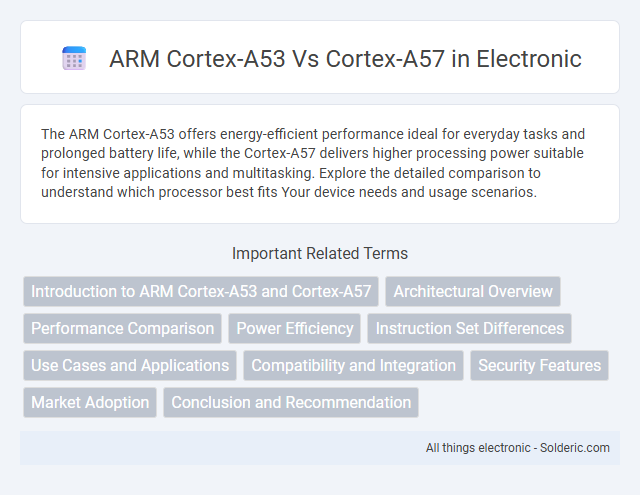The ARM Cortex-A53 offers energy-efficient performance ideal for everyday tasks and prolonged battery life, while the Cortex-A57 delivers higher processing power suitable for intensive applications and multitasking. Explore the detailed comparison to understand which processor best fits Your device needs and usage scenarios.
Comparison Table
| Feature | ARM Cortex-A53 | ARM Cortex-A57 |
|---|---|---|
| Architecture | ARMv8-A (64-bit) | ARMv8-A (64-bit) |
| Core Type | Energy-efficient, in-order | High-performance, out-of-order |
| Performance | Lower power, moderate speed | High speed, intensive workloads |
| Pipeline Depth | 8 stages | 15 stages |
| L1 Cache | 32 KB I-cache, 32 KB D-cache | 64 KB I-cache, 64 KB D-cache |
| L2 Cache | Up to 512 KB | Up to 2 MB |
| Max Frequency | Up to ~1.5 GHz | Up to ~2.5 GHz |
| Process Technology | 28 nm to 14 nm | 28 nm to 14 nm |
| Use Case | Mobile, low-power devices | High-performance smartphones, servers |
| Release Year | 2012 | 2012 |
| Features | 64-bit support, NEON, VFPv4 | 64-bit support, NEON, VFPv4, Out-of-order execution |
Introduction to ARM Cortex-A53 and Cortex-A57
ARM Cortex-A53 is a power-efficient, 64-bit processor designed for mid-range smartphones and embedded systems, featuring a focus on energy savings and cost-effectiveness. Cortex-A57 offers higher performance with out-of-order execution and enhanced microarchitecture, targeting premium devices and workloads requiring substantial computational power. Your device's choice between these cores impacts performance and battery life, with Cortex-A57 delivering superior speed and Cortex-A53 emphasizing efficiency.
Architectural Overview
The ARM Cortex-A53 features a 64-bit ARMv8-A architecture with a focus on energy efficiency using an in-order execution pipeline, making it ideal for low-power devices. In contrast, the Cortex-A57 implements a more powerful 64-bit ARMv8-A architecture with an out-of-order execution pipeline, delivering higher performance suitable for high-end applications. Both cores support advanced features like virtualization, NEON SIMD extensions, and TrustZone security technology, but the A57's microarchitecture enhances instruction-level parallelism and branch prediction for superior processing capability.
Performance Comparison
The ARM Cortex-A57 delivers significantly higher performance than the Cortex-A53 due to its out-of-order execution and higher clock speeds, making it suitable for demanding applications and multitasking. Cortex-A53, with its in-order architecture, prioritizes power efficiency and is ideal for less intensive tasks and extended battery life. Your choice between these cores will depend on whether performance or energy efficiency is your primary requirement.
Power Efficiency
ARM Cortex-A53 offers superior power efficiency compared to the Cortex-A57 due to its 64-bit, low-power design optimized for energy-conscious applications. The A53's in-order, simpler pipeline architecture significantly reduces power consumption while maintaining adequate performance for mid-range devices. In contrast, the Cortex-A57, designed for high-performance tasks, consumes more power with its out-of-order execution and higher clock speeds, making it less suitable for battery-sensitive environments.
Instruction Set Differences
The ARM Cortex-A53 supports the ARMv8-A 64-bit instruction set architecture, featuring AArch64 and AArch32 modes, optimized for energy efficiency and compatibility with both 32-bit and 64-bit applications. The Cortex-A57 also implements the ARMv8-A ISA but emphasizes high performance with wider instruction issue and out-of-order execution, enhancing throughput for more complex 64-bit workloads. Instruction set enhancements in Cortex-A57 include advanced SIMD capabilities and optimized branch prediction that improve computational intensity over the Cortex-A53.
Use Cases and Applications
The ARM Cortex-A53 excels in energy-efficient applications such as smartphones, embedded systems, and IoT devices where low power consumption is critical. In contrast, the Cortex-A57 targets high-performance use cases including tablets, laptops, and servers that require powerful processing capabilities for demanding tasks. Your choice between these cores depends on whether energy efficiency or computational performance is the priority for your application.
Compatibility and Integration
ARM Cortex-A53 and Cortex-A57 cores offer robust compatibility within ARM's big.LITTLE architecture, enabling seamless integration in heterogeneous multi-core designs. Both cores support ARMv8-A 64-bit instruction set, ensuring software compatibility across applications while differentiating in performance and power efficiency. Integration benefits from shared system interfaces and coherent interconnects, facilitating dynamic workload management between Cortex-A53's energy efficiency and Cortex-A57's high-performance capabilities.
Security Features
The ARM Cortex-A53 includes TrustZone technology, providing a hardware-based secure environment to isolate sensitive operations and enhance system security. The Cortex-A57 builds on this foundation with improved cryptographic acceleration and better support for virtualization, enabling more robust security in high-performance applications. Both cores support ARM's Pointer Authentication (PAC), mitigating pointer corruption attacks and enhancing code integrity in modern ARM architectures.
Market Adoption
ARM Cortex-A53 has seen widespread market adoption in entry-level and mid-range smartphones, tablets, and embedded systems due to its energy efficiency and cost-effectiveness. Cortex-A57 targets high-performance applications, including flagship devices and servers, delivering robust computing power at higher energy consumption. Your choice between these cores should consider the balance between performance needs and power efficiency for optimal device functionality.
Conclusion and Recommendation
The ARM Cortex-A57 delivers superior performance with its out-of-order execution and higher clock speeds, making it ideal for demanding applications and multitasking. The Cortex-A53 offers improved energy efficiency and cost-effectiveness, better suited for devices prioritizing battery life and thermal management. Your choice depends on whether you prioritize raw processing power or long-lasting, efficient performance for mobile or embedded systems.
ARM Cortex-A53 vs Cortex-A57 Infographic

 solderic.com
solderic.com